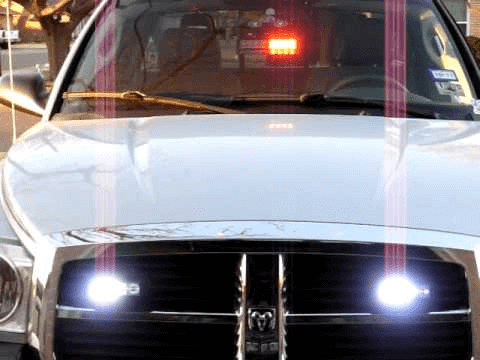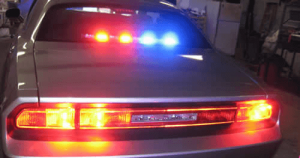How Many Emergency Vehicle Lights Should I Put On My POV?
Posted by Extreme Tactical Dynamics on Jun 29th 2019
Emergency lights being used on a personal operating vehicle (POV) can be a contentious subject. Some people believe that emergency lights should be restricted to emergency vehicles only. Others contend that emergency lights on a POV can be justified, and help to both alert road users and improve road awareness as a result. We’re inclined to agree with the latter; emergency lights on POVs may be something of a nuisance, but in some cases, they could be the difference between life and death.
Who uses emergency lights on their POVs?
There are a number of different occupations that may require the use of emergency lights on a POV, including:
- EMTs and first responders often place emergency lights on their POV in case of emergencies. If they are on call, or off-work when a major incident occurs, they can use their personal vehicle to help cut through traffic and thus arrive at the scene quicker.
- Volunteer firefighters use emergency lights on their POV for the same reason.
What do emergency lights on POVs do?
In essence, emergency lights being used on a POV are used as courtesy lights. They do not give the vehicle permission to break the speed limit, ignore stop signs, and otherwise break the rules of the road (as official emergency vehicles are permitted to do). Instead, lights on a POV can help the driver to signal to other road users that they need to be given right of way. Whether or not other drivers comply with this is entirely at the discretion of the driver.
Emergency lights should not be confused with warning lights that are used on vehicles that are carrying a large load, acting as a funeral car, or are towing other vehicles. These lights are being used not to request courtesy, but to provide awareness to other road users.
How many emergency vehicle lights should I put on my POV?
 Now to the nitty gritty; if your POV falls into one of the categories above, you have to decide how many lights you can use.
Now to the nitty gritty; if your POV falls into one of the categories above, you have to decide how many lights you can use.
For the most part, the number of lights is entirely at your discretion. You could use 50 if you wanted (and they fit on your vehicle) if you so choose, though it’s not recommended-- you’re looking to inform other writers, not blind them!
Many people who use emergency lights on their POV largely choose the number of lights from their own personal preference. Some people choose to use a large number of lights, justifying the decision with the fact that if they need to use those lights, they need to be seen. These people tend to adhere to a philosophy of “the more lights the better”, and are commonly known as “whackers”. You can see videos online of people proudly showing off their “whacker” POV-- and if this is the kind of look you want to achieve, then go for it, providing your car can bear the weight and you don’t mind the extra fuel costs.
On the other side of the debate is the people who choose to use a single, simple light such as an LED dash light on their POV. This is advantageous for the car owner, and ensures that the personal vehicle is still clearly a personal vehicle. However, some people -- predominantly “whackers”, admittedly -- say that a single light is too few, and may not be able to alert drivers further ahead in the same way multiple lights can.
So where should you fall on the issue? It’s very much up to you. It’s always wise to check with your local authority to see if they have restrictions, or preferences, about how many lights you can use. With that done, the rest of the decision-making is largely your own.
Perhaps the best decision is to fall somewhere between the two camps. Don’t go for the out-and-out light show of a whacker, but use more than a single light on your vehicle. This helps to ensure maximum fuel efficiency and lower purchase costs, but does not compromise your ability to be seen when the lights need to be in use.
What color should POV emergency lights be?
 While the number of lights you can have is largely unrestricted, the color of the lights is more firmly regulated. The color emergency lights you choose is decided by your state, so before you install any lights, you will need to be sure you have the right colors.
While the number of lights you can have is largely unrestricted, the color of the lights is more firmly regulated. The color emergency lights you choose is decided by your state, so before you install any lights, you will need to be sure you have the right colors.
There are guides online as to what color of light is permitted in each state but, in truth, these are not reliable. Regulations change; information is recorded inaccurately; mistakes are made. The color of light is important, so your best bet is always to call your state’s local authority and ask them directly for the color of the light and what kind of light it should be-- the latter because some states require, for example, oscillating lights.
If you do decide to trust information you find online, then be extremely cautious, as there is no guarantee it is correct or up-to-date. If you’re in doubt, a quick phone call can ensure that your lights comply with the state regulations, and you can be sure you’ve covered all your bases. Get more information about why you shouldn't impersonate Emergency Services, and state laws here.
When should emergency lights on a POV be used?
Only when the vehicle is being used to transport a volunteer firefighter or an EMT to a work-related emergency. Emergency lights cannot be used for any other purpose, and owners should adhere to this to ensure emergency lights can continue to be installed on POVs in the future.
Depending on your state, if you do use your emergency lights for a non-emergency reason, you may be subject to a fine.
In conclusion
Emergency lights on POVs may be a controversial subject, but there’s no doubt they serve a valuable purpose to the community. When choosing the number of lights to use on your vehicle, try and opt for a “middle of the road” approach-- you want enough to be seen, but not so many as to dazzle other motorists and risk being dubbed a whacker.
Related Posts
- Emergency Lights Help First Responders with the Move Over Law
- Popular Off Road Lights for Pickup Trucks
- Mini Light Bars are Perfect for Construction Company Vehicles
- Putting Together A Police Light Package
- The Evolution of the Humble Police Car
- Top 5 Emergency Vehicle Lights for Volunteers
 Facebook
Twitter
Google+
Instagram
YouTube
Facebook
Twitter
Google+
Instagram
YouTube

